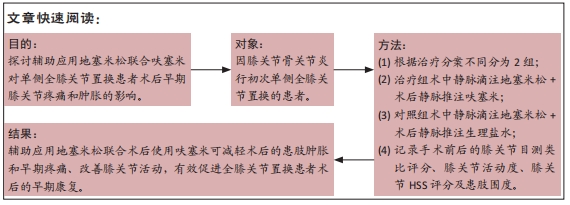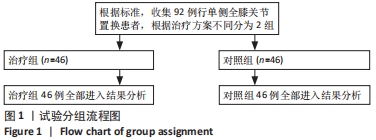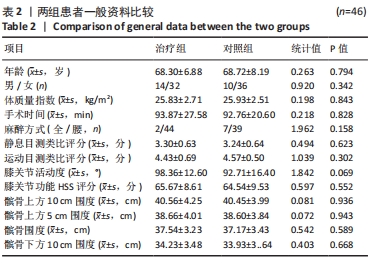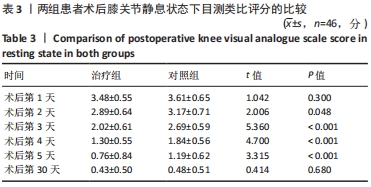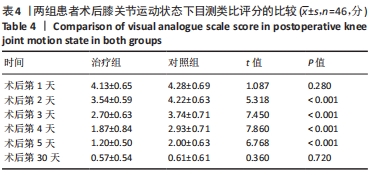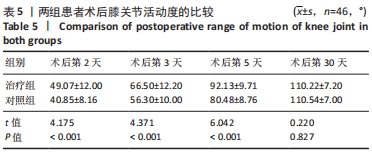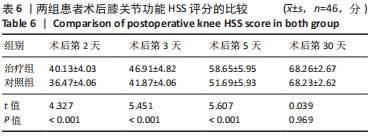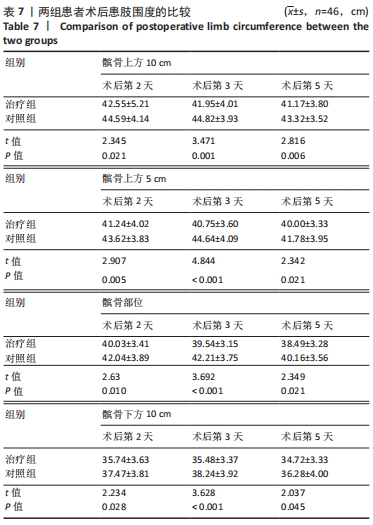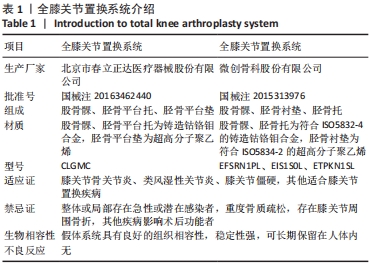[1] MISRA D, BOOTH SL, TOLSTYKH I, et al. Vitamin K defificiency is associated with incident knee osteoarthritis. Am J Med. 2013;126:243-248.
[2] SUN YQ, YANG B, TONG SL, et al.Patelloplasty versus traditional total knee arthroplasty for osteoarthritis. Orthopedics. 2012;35(3):e343-348.
[3] SEO SS, KIM OG, SEO JH, et al. Comparison of the effect of continuous femoral nerve block and adductor canal block after primary total knee arthroplasty. Clin Orthop Surg. 2017;9:303-309.
[4] ASO K, IZUMI M, SUGIMURA N, et al. Additional benefifit of local infifiltration of analgesia to femoral nerve block in total knee arthroplasty: double-blind randomized control study. Knee Surg Sports Traumatol Arthrosc. 2019;27:2368-2374.
[5] LI X, XU G, XIE W, et al. The efficacy and safety of dexamethasone for pain management after total knee arthroplasty: A systematic review and meta-analysis. Int J Surg. 2018;53:65-71.
[6] BIAN YY, WANG LC, QIAN WW, et al. Role of parecoxib sodium in the multimodal analgesia after total knee arthroplasty: a randomized double-blinded controlled trial. Orthop Surg. 2018;10:321-327.
[7] HAWKER GA. Osteoarthritis is a serious disease. Clin Exp Rheumatol. 2019;37 Suppl 120(5):3-6.
[8] HAFER JF, KENT JA, BOYER KA. Physical activity and age-related biomechanical risk factors for knee osteoarthritis. Gait Posture. 2019; 70:24-29.
[9] HERMANN W, LAMBOVA S, MULLER-LADNER U. Current Treatment Options for Osteoarthritis. Curr Rheumatol Rev. 2018;14(2):108-116.
[10] LI JW, MA YS, XIAO LK. Postoperative Pain Management in Total Knee Arthroplasty. Orthop Surg. 2019;11(5):755-761.
[11] GROSU I, LAVAND’HOMME P, THIENPONT E. Pain after knee arthroplasty: an unresolved issue. Knee Surg Sports Traumatol Arthrosc. 2014;22(8):1744-1758.
[12] 徐建国.成人术后疼痛治疗进展[J].临床麻醉学杂志,2011,27(3): 299-301.
[13] GRAZIOLI L, OLIVETTI L, FUGAZZOLA C, et al. The pseudocapsule in hepatocellular carcinoma: correlation between dynamic MR imaging and pathology. Eur Radiol. 1999;9(1):62-67.
[14] JIANG M, DENG H, CHEN X, et al. The efficacy and safety of selective COX-2 inhibitors for postoperative pain management in patients after total knee/hip arthroplasty: a meta-analysis. J Orthop Surg Res. 2020;15(1):39.
[15] LIN J, ZHANG L, YANG H. Perioperative administration of selective cyclooxygenase-2 inhibitors for postoperative pain management in patients after total knee arthroplasty. J Arthroplasty. 2013;28(2):207-213.e2.
[16] DIMACULANGAN D, CHEN JF, BORZIO RB, et al. Periarticular injection and continuous femoral nerve block versus continuous femoral nerve block alone on postoperative opioid consumption and pain control following total knee arthroplasty: randomized controlled trial. J Clin Orthop Trauma. 2019;10:81-86.
[17] KIM HC, KIM TK, SUNG KB, et al. Preoperative evaluation of hepatocellular carcinoma: combined use of CT with arterial portography and hepatic arteriography. AJR Am J Roentgenol. 2003; 180(6):1593-1599.
[18] EL-BOGHDADLY K, SHORT AJ, GANDHI R, et al. Addition of dexamethasone to local infiltration analgesia in elective total knee arthroplasty: double-blind, randomized control trial. Reg Anesth Pain Med. 2021;46(2):130-136.
[19] KASSIM DY, ESMAT IM, ELGENDY MA. Impact of duloxetine and dexamethasone for improving postoperative pain after laparoscopic gynecological surgeries: A randomized clinical trial. Saudi J Anaesth. 2018;12(1):95-102.
[20] FAN Z, MA J, KUANG M, et al. The efficacy of dexamethasone reducing postoperative pain and emesis after total knee arthroplasty: A systematic review and meta-analysis. Int J Surg. 2018;52:149-155.
[21] TAMMACHOTE N, KANITNATE S. Intravenous Dexamethasone Injection Reduces Pain From 12 to 21 Hours After Total Knee Arthroplasty: A Double-Blind, Randomized, Placebo-Controlled Trial. J Arthroplasty. 2020;35(2):394-400.
[22] 陆蒂青,张冬云,闪海霞.甘露醇联合地塞米松对感染性脑水肿患者相关指标的影响[J].中国药房,2017,28(24):3362-3364.
[23] GASBJERG KS, HÄGI-PEDERSEN D, LUNN TH, et al. DEX-2-TKA -
DEXamethasone twice for pain treatment after Total Knee Arthroplasty: Detailed statistical analysis plan for a randomized, blinded, three-group multicentre clinical trial. Acta Anaesthesiol Scand. 2020;64(6):839-846.
[24] GODSHAW BM, MEHL AE, SHAFFER JG, et al. The Effects of Peri-Operative Dexamethasone on Patients Undergoing Total Hip or Knee Arthroplasty: Is It Safe for Diabetics? J Arthroplasty. 2019;34(4):645-649.
[25] GATEWOOD CT, TRAN AA, DRAGOO JL. The efficacy of post-operative devices following knee arthroscopic surgery: a systematic review. Knee Surg Sports Traumatol Arthrosc. 2017;25(2):501-516.
[26] HOLM B, KRISTENSEN MT, BENCKE J, et al. Loss of knee-extension strength is related to knee swelling after total knee arthroplasty. Arch Phys Med Rehabil. 2010;91:1770-1776.
[27] 钟洁珠.呋塞米联合甘露醇治疗急性肢体肿胀患者的效果分析[J].临床合理用药杂志,2013,6(8):70-71.
[28] GRADALSKI T. Diuretics Combined With Compression in Resistant Limb Edema of Advanced Disease-A Case Series Report. J Pain Symptom Manage. 2018;55(4):1179-1183.
[29] GRADALSKI T. Multicomponent Compression Bandaging Combined with Diuretic Therapy of Anasarca Secondary to Palliative Chemotherapy: A Case Report. J Palliat Med. 2021;24(1):144-147.
[30] 陈洁,田义华,唐永利,等.全膝关节置换术后患肢不同体位对肢体肿胀与关节活动度的影响[J].重庆医科大学学报,2020,45(10): 1506-1508.
|
